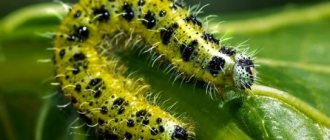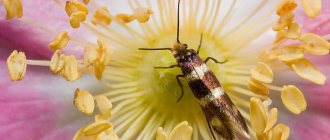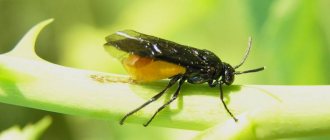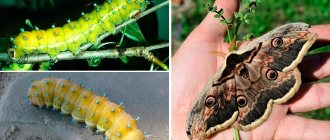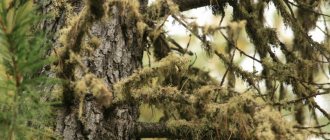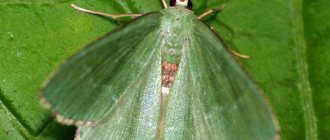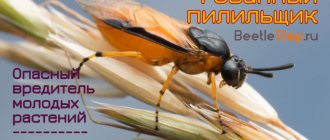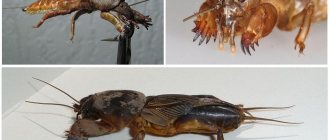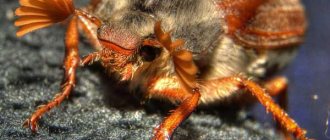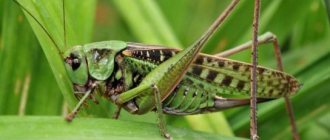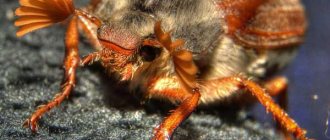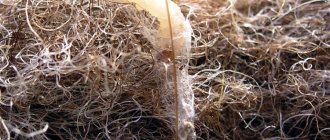A tall, slender coniferous tree with an elegant trunk immediately attracts attention: pine grows in significant quantities in the forests of our latitude. The aroma of pine needles calms the nerves, and wood is widely used in construction and furniture production. However, pine can be seriously affected by pests, and the pine sawfly (caterpillars on pine trees) is considered one of the most dangerous species. The insect belongs to the order Hymenoptera, there are two varieties - the common sawfly and the red one.
Common Sawfly
Larva
The body color of the false caterpillar of this type of insect varies from pale yellow to green . On the abdomen of the larva there are black spots located above each false leg, of which there are from 18 to 22. The head is shiny, round, brown or dark brown in color. The length of the false caterpillar reaches 25 mm .
Adult
The maturation of the female common sawfly occurs in 6 stages, while the male goes through 5 instars. The female adult insect has a convex body with a color ranging from light yellow to red. There are black spots along the perimeter. The antennae are saw-like. The size of the female individual does not exceed 10 mm.
The color of males is usually black or dark brown, the legs are red. The size of the male individual is slightly smaller (6-8 mm). The antennae are strongly combed.
Description of the pest
Larva
The size of the red larva is 2–2.5 centimeters. The body color is light gray with a white stripe down the center of the back. On the sides there are black stripes with white trim. The head is black, shiny.
The color of the common larvae is yellow or light green. The abdomen is yellowish with black spots above each false leg. The body reaches a length of two and a half centimeters. The head is brown, shiny.
The larvae, or false caterpillars, emerge from the eggs in the second ten days of April or early May. They stay in groups, feeding on needles.
Young larvae eat the edges of the needles, while older larvae destroy them completely.
Able to move from one tree to another.
Growing up occurs in six stages. At the last stage, in mid-June, the larvae descend from the trees into the forest floor. Some of them plunge into a kind of hibernation. Some individuals remain in this inhibited state for up to two years, without needing additional nutrition.
For the winter, some larvae climb into the forest floor or soil (to a depth of ten centimeters). Others hide in the bark at the base of tree trunks.
The pupa resembles an adult. It is located in a yellowish, elongated cocoon up to a centimeter long.
Adult
Females of both species are yellowish in color. There are black oval spots on the chest and abdomen. Length from 0.7 to 0.9 cm.
The male is distinguished by a black color throughout his body. Legs are reddish in color. The antennae are comb-shaped.
After mating, females lay eggs in tree needles, first ripping them open with their ovipositor. The laying occurs in even rows. One laying can contain up to one hundred and fifty eggs.
The eggs are oval-shaped, translucent or greenish in color. The development of the embryo continues in them until the beginning of spring. The eggs are covered on top with a special foamy liquid secreted by the female during laying.
Red Sawfly
Larva
The body of the red sawfly larva is light gray in color . A white stripe is visible along the back; on the sides above each leg there are black spots with light speckles. The head is round, shiny, black. The size of the false caterpillar does not exceed 25 mm .
Adult
The external characteristics of adults of both species are the same.
Interesting : As a rule, the development of larvae is a long process that lasts several months. In a toga, the false caterpillar pupates in the crown of a tree and after 2 weeks an adult is born. But it happens that the caterpillar descends to the ground and camouflages itself in the grass, fallen pine needles, hibernating. In this form, the larva can remain for 24 months without feeding.
Sawfly in a wooden house
When building a house from pine and other coniferous trees, there is a high risk of sawfly larvae colonizing the material. The result will be damaged wood, deterioration in the quality and appearance of the structure.
A preventative measure for the spread of this coniferous pest in a wooden house should be considered the treatment of wood with special repellent and sawfly-killing compounds. However, simply spraying with a spray bottle is not a sufficient measure to prevent the proliferation of sawflies in a wooden structure. Today, pest control specialists offer more effective methods for exterminating pests of coniferous trees.
Today, two effective methods are used to destroy adult sawflies and their larvae:
- fumigation with phosphine;
- Microwave irradiation of wood.
Both exposure options are highly effective and, when used correctly, do not have a negative impact on the health of people living in the house.
Fumigation with phosphine
When wooden buildings are treated with this chemical compound, adults and larvae are quickly destroyed. This allows you to quickly clean the house of pests and prevent re-infestation.
magtoxin tapes
magtoxin tapes
magtoxin tablets
Phosphine is distributed deep into the affected wood through the passages made in it by insects. Specialists use special devices, special clothing and gas masks for this purpose. After completing the procedure, the room should be ventilated for several days.
Using microwave processing
Among other processing options, the microwave method is considered particularly effective. Drooping deep into the log, microwave radiation ensures the complete death of both adult pine sawfly individuals and its larvae. And this prevents the tree from becoming infected to a greater extent.
During exposure, the wood heats up to 60°C, but this does not affect the condition of the fibers. Pest control specialists thoroughly treat each tree that is infected with pine sawfly or has reason to suspect infection. The results of using devices that perform microwave processing of wood are as high as possible: wooden buildings made from wood treated by this method are not re-infected and retain their natural aesthetic appearance and strength for a long time.
Nutrition
At the beginning of spring, the pest larvae feed on old pine needles. Next, the insects move on to younger shoots, causing damage not only to the needles, but also to thin branches.
The larvae “act” in groups, eating needles, leaving only stumps. One false caterpillar can destroy up to 40 needles.
Our experts have prepared articles about shrews, bedbugs, mole crickets, woodlice, ants, mice, nematodes, locusts, slugs and methods of combating them.
How to protect trees in the forest?
During the period of mass reproduction, the pest in question attacks huge forest areas. It is very problematic to fight the sawfly manually. Chemical and biological agents are also used to eliminate it.
The degree of infestation of coniferous trees is determined visually by the presence of larvae, their excrement and cocoons on the coniferous litter. Of the mechanical methods in the forest, the only suitable method is to install special trap rings that prevent the larvae from descending and moving between trees.
The rings are adhesive elements or fabric material impregnated with a special agent. Insecticides are the best chemicals for pine sawfly. Trees are treated with preparations that have an internal contact effect, making it possible to eliminate the pest not only externally, but also through the food it consumes. To increase the effectiveness of treatment, it is advisable to use several different insecticides.
What harm do they cause?
Damage to coniferous plantations is caused not only by larvae, but also by adult pests that also eat needles. After the first ones eat the needles, they dry out, turn yellow and then fall off.
When there is not enough food, the insect eats the bark and young shoots, which leads to the death of branches in the crown. Over time, the plant loses vigor, becomes sick and, as a result, dies. If a pine sawfly attack occurs on a young pine tree, it will inevitably die within 3-4 years.
Due to the weakening of the plant, it becomes easy prey for other pests and is susceptible to many diseases.
Prevention
The female will not lay pine sawfly eggs if tomatoes grow near the pine trees, the smell of which repels the insect. Prevention also includes the attraction of natural enemies of the pest - ants and insectivorous birds.
High humidity leads to the death of the sawfly. Also, when forming plantings, they should be mixed, alternating pine trees with rows of deciduous trees. It is advisable to make the edges dense, planted with dense bushes. On soils poor in nitrogen, it is necessary to carry out enrichment by sowing perennial lupine. Among the natural enemies of the pine sawfly are the tahini parasites and the parasite. One of them parasitizes insect eggs, and the second lays eggs that damage the larvae in the cocoon.
The difference between the pine sawfly and other species
It is worth noting that outbreaks of reproduction in a specific localization are more typical for this pest, but it happens that reproduction occurs over large areas.
The pine sawfly produces 2 generations per year - in the last weeks of spring and in mid-summer. An increase in the number of this species is favored by an increase in environmental temperature - the higher it is, the faster the development occurs.
If we add a decrease in air humidity to the temperature factor, the conditions become ideal for the development of insect resistance to various harmful influences.
If such conditions persist for 2 years, the reproduction of the pest takes on such proportions that all plants around are susceptible to its attack.
We present to your attention photos of pine sawflies:
Read about the variety of sawfly species here.
Geographical distribution
Sawflies Acantholyda erythrocephala are found in Northern and Central Europe, Ukraine, and Kazakhstan. The phytophage was introduced to North America in 1925. In the northern states and Canada, redhead weaver is a major pest of white pine. The European part, Siberia, Altai and Krasnoyarsk territories are the habitats of the sawfly in Russia.
The bread sawfly is distributed in the European part of Russia to the Leningrad and Yaroslavl regions in the north. The pest's range covers the Caucasus, Siberia, Central Asia, Western Europe, North Africa, the Middle East, Arabia, Northern Iran, the Hindustan Peninsula, Southeast Asia, and was introduced to Canada and the USA.[4]
Control measures
In coniferous forests, it is quite difficult to defeat the pest, but still some control methods exist, and they can help get rid of the harmful insect.
Glue rings
You can create a ring like this by applying glue to the bottom of a tree trunk. During the period when the larvae begin to descend in order to form a cocoon, they will fall into the created trap and soon die. In addition, the glue trap prevents the larvae from climbing up the trunk to the crown of the tree.
Important : the glue must be moisture resistant and not dry out!
How to deal with sawfly
Sawfly remedies (preparations)
In order to save the plant from the sawfly, chemicals, or rather insecticides, are often used. The most effective insecticidal agents:
- Karbofos . This is a contact insecticide-acaricide with a wide spectrum of action. It is included in most drugs.
- Benzophosphate . This organophosphorus insecticide-acaricide has an intestinal-contact effect.
- Metaphos . This is a contact insecticidal preparation with broad-spectrum acaricidal properties. Its active substance is parathion methide.
- Chlorophos . This insecticide and pesticide of contact-intestinal action are widely used in the fight against harmful insects of various plants.
- Phosphamide . This systemic and contact-acting acaricide and insecticide is absolutely harmless to warm-blooded animals.
- Arrivo . This broad-spectrum insecticidal preparation is characterized by contact and intestinal action. Cypermethrin is its main active substance.
- Virin-Diprion . This viral remedy is used to exterminate pests on all plants, including trees.
- Aktara . This insecticidal agent of the neonicotinoid group is distinguished by its high effectiveness against most pests.
- Karate . This enteric-contact pyrethroid insecto-acaricide is highly effective even with low product consumption. Its active substance is lambda-cyhalothrin.
- Confidor . This insecticidal agent of systemic contact-intestinal action is used in the fight against gnawing and sucking pests. The active substance is imidacloprid.
- Mospilan . A systemic insecticidal agent characterized by contact and intestinal action.
- Kinmiks . A broad-spectrum pyrethroid insecticidal preparation that is highly effective.
- Decis . This is a garden contact-intestinal insecticidal preparation that blocks the digestive system of the pest. The active substance is deltamethrin.
In addition to these means, many others are used in the fight against sawflies.
Preventive measures
In order to protect your site from sawflies, it is recommended not to forget about preventive measures:
- In the trunk circles of shrubs and trees, the soil surface must be systematically dug up and loosened. Thanks to this, quite a lot of sawfly larvae and pupae will die.
- Dried and diseased trees should not be in the garden, as pupated pests prefer to overwinter in them.
- Those ovaries that are injured by the beetle should be cut off and destroyed by fire or buried in the soil to a depth of at least half a meter.
- At the beginning of spring, it is recommended to wear hunting belts on tree trunks. You can also use pheromone traps to combat sawflies.
Folk remedies
You can fight the sawfly with various folk remedies:
- At the initial stage of development, in the fight against this pest, you can use an infusion of the herb aconite, which must be collected during flowering. To prepare the infusion, you need to combine 1 bucket of water and 1 kilogram of herb, and 30 milligrams of alkali are also poured into the mixture. The product will be ready after 2 days. Before you start spraying the plants, pour 40 to 50 grams of liquid soap into the product.
- In order to get rid of pest larvae, use chamomile infusion. To do this, pour a kilogram of crushed leaves and chamomile flowers into a bucket of water, the temperature of which should be from 60 to 70 degrees (the grass is collected during flowering). The infusion will be ready after 12 hours, then it is filtered and diluted with water 1:1. You need to add 40 grams of liquid soap to the bucket of the prepared solution.
- 1.2 kg of fresh wormwood herb is dried and then mixed with 1 bucket of water. The infusion will be ready in 3 days. Then you need to pour 50 to 100 grams of baking soda into the strained product.
- 10 liters of water are combined with two kilograms of pine needles. The mixture is stirred every day for one week, during which time it should be kept in a dark place. The strained infusion should be diluted with water in a ratio of 1:3 or 1:5.
- One bucket of water is combined with 70 grams of soda ash and 20 grams of liquid soap.
- A bucket of hot water is mixed with three kilograms of sifted wood ash. The infusion will be ready in 2 days; it is filtered through a small sieve or gauze. Before processing, 40 grams of liquid soap are poured into it.
- One bucket of water is combined with a kilogram of fresh tansy. The mixture is boiled for two hours and waited until it cools down. 40 grams of liquid soap are poured into the strained product.
It is recommended to use folk remedies only when there are very few sawflies. But most summer residents use them only as a means of prevention.
What to do if a pest appears in your garden plot?
The pine sawfly can appear in a summer cottage. In this case, it is worth taking the following measures:
- Tomatoes are planted near diseased trees; they will repel pests.
- Infected needles are dug up.
- Use of special biological products.
- Sick trees are sprayed with an infusion of tobacco, tomatoes and mustard.
If a small pine tree grows near your dacha, then you should collect all the larvae yourself. It is recommended to wear goggles and gloves, as pests can cause allergies. So, pine sawflies are dangerous pests. If they are found on needles, you should start destroying them. Otherwise, the trees may die.
Video about a dangerous pest:
Lesser pine beetle
The small pine beetle's lifestyle is very similar to the large one, but the flight of the beetles begins one to two weeks later, and the females bore under the thin bark in the upper part of the pines not longitudinal, but transverse, bracket-shaped uterine passages deeply imprinted on the sapwood. Short larval galleries extend up and down from the uterine galleries, ending deep in the sapwood with a pupal cradle.
The small pine beetle gnaws the core of young shoots. The passages of the small pine beetle.
Young beetles also undergo additional feeding in the crowns, gnawing the core of young shoots, and then overwinter in the forest litter. The generation is annual.
Both species of pine beetles are quite shade-loving and are found everywhere in the pine habitat in a wide variety of planting types. The large pine beetle dominates the small pine beetle in wetter forest types.
Pines with increased resistance are able to repel the attack of pine beetles by filling their entrance channels with abundant resin, which, when hardened, forms characteristic cone-shaped funnels. The presence of such craters on pine trunks is an alarming sign of reduced tree resistance to bark beetle attacks.
Bark beetles feed on weakened pine trees and actively colonize burnt areas, pockets of root fungus, and pine forests weakened by excessive recreational load and man-made emissions. These pests are often found on large transplanted pines in private areas.
As a rule, trees infested with pine beetles cannot survive and dry out.
By burrowing under the bark, pests transmit spores of wood-staining fungi, reducing the grade of wood. The frequent occurrence of pine beetles is an indicator of the general weakening of plantings. Due to the peculiarities of their additional feeding, pine beetles, when in high numbers, can cause a significant (up to 20%) loss of current year shoots in living trees, weakening them and preparing them for future colonization.
Plants at risk
The greatest damage is caused to pine trees up to 30 years old. Scots pine is damaged, but sometimes Weymouth pine, Banks pine and other ornamental pines are damaged. The most damaged trees are usually those on the edges and trees growing alone, on elevated terrain with dry, sandy and sandy loam soils.
In the photo: damage to a Weymouth pine shoot by sawfly larvae
Competition “Bio/Mol/Text”-2021/2022
This work was published in the “School” category of the “Bio/Mol/Text” competition - 2021/2022.
The nomination partner is the non-profit boarding school “Letovo”.
The general partner of the competition is the international innovative biotechnology company BIOCAD.
The general partner of the competition is: the largest supplier of equipment, reagents and consumables for biological research and production.
"Book" sponsor of the competition - "Alpina Non-Fiction"
One June morning, when the streets of the city were already filling with people, I left the house. At the gate, one tree caught my attention. On a pine branch, black creatures that looked like caterpillars were devouring the needles (Fig. 1). In fear, I immediately ran for garden shears, cut and burned the shoot, full of strange insects. Before destruction, I photographed the pine pests in order to ask the question “What kind of caterpillars are these?” on social networks. Amateur entomologists replied that these were not caterpillars at all and that I should quickly get rid of these creatures, which I did.
Figure 1. I encountered such a miracle for the first time...
photo of the author of the article
My actions turned out to be correct. The pine would have remained bald if I had not destroyed these arthropods. The phenomenon when a tree is left without leaves is called defoliation . Everyone has seen a pine tree at least once in their life. It’s hard not to agree that this plant would look terrible without the needles. And even its life could be in danger if it were deprived of green leaves, in the chloroplasts of whose cells photosynthesis occurs. The role of photosynthesis for living organisms on Earth is undeniable.
Scots pine (Pinus sylvestris) is also of interest to humans - from a commercial and aesthetic point of view. Wood is used in construction, furniture and paper making. Turpentine and rosin are obtained from the resin. Pine is often used in medicine and dendrochronology. During the New Year holidays, this plant decorates many homes as a “Christmas tree.”
The lyrical digression is over, it’s time to find out the name of the pine pest. This nasty arthropod is called the red pine sawfly (Neodiprion sertifer) and belongs to the pine sawfly family, which is part of the order Hymenoptera. This means that sawflies are relatives of bees, wasps and ants and therefore at any stage of their development cannot be called caterpillars, since caterpillars are the larvae of butterflies, and butterflies are classified as Lepidoptera.
Damage to crops
Although these pests are very small in size, they are capable of causing enormous damage. There may be 2-3 larvae per square meter. Rapeseed sawflies prefer shoots of radish, rapeseed, mustard, rutabaga and cabbage.
The first generation of rapeseed sawfly larvae are especially harmful.
The main diet of these pests are buds, leaf pulp and young pods. At the same time, rapeseed sawflies eat up the leaves almost completely; after these pests, only cuttings of the leaves remain. After exposure to sawflies, the shoots dry out, fruits do not form, and the yield is significantly reduced. Rapeseed sawflies pose a particular threat to rapeseed and turnips; sometimes they destroy 80-95% of the crop.
If you find an error, please select a piece of text and press Ctrl+Enter.
Preventive measures
To avoid having to get rid of the voracious larvae, it is better to secure the plantings in advance:
- Sawflies prefer damp areas. Lack of moisture in the soil leads to massive death of larvae. It is best to plant crops susceptible to this pest in well-drained soil and a well-lit place, try not to flood the plantings, and reduce watering during heavy rainfall.
- Most species of sawfly live in the forest, but are able to cover distances of up to 500-600 meters. If it is located near a summer cottage or garden plot, the plantings should be placed as far away as possible.
- For the winter, be sure to dig to a depth of 5-10 centimeters and loosen the soil around trees and shrubs. This allows you to raise larvae to the surface, which die if they remain on the surface in cold weather.
Keep the area free of weeds throughout the season and into the fall.
Types of sawfly and the fight against it
Rate this post
